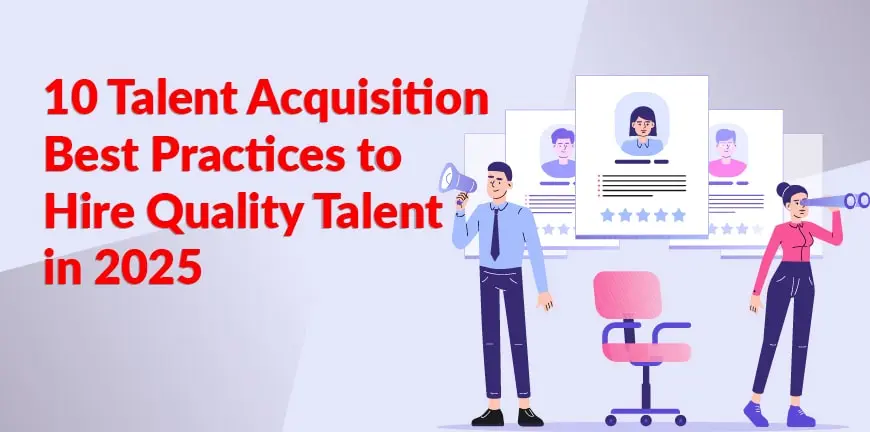
The Digital Agricultural Mission in India – How Technology Can Make It a Success
09/11/2024
10 Talent Acquisition Best Practices to Hire Quality Talent
11/11/2024Your business depends on the leaders you have in your organization. Employees in leadership positions can either make your business or break it. And the real challenges companies are facing lately are finding these leaders who can make their business. The solution to this is break away from the old-fashioned hiring practices and use data-driven hiring methods to bring in top executives. In this article, we’ll be exploring some of the top executive search trends for 2025, that can help your organization acquire world class leadership teams and drive transformational growth for your business.
How Modern Executive Search Boosts Your Business?
In the past, companies heavily relied on mainstream tactics like job ads, networking events and interviews filled with basic, boring questions. While this did bring in candidates with the right “so called criteria” it failed at bringing in those with creativity, visionary thinking and change leadership drive that gives rise to exceptional talent. In order to win talent, strategic differentiation is essential. This is where embracing current trends in executive search industry can make all the difference. This approach can provide insights into candidates beyond skills and experience.
In today’s complex business world full of volatility and uncertainty, unconventional thinking gives you a clear advantage. One that’s becoming vital to securing executive talent able to deliver transformational impact
7 Executive Search Industry Trends in 2025
1. The storytelling approach
If you are looking to attract top talent for leadership positions, you must highlight your company’s purpose, mission and vision. Communicating the latter can help form deeper emotional connections with the executive level individuals. Some of the things you can incorporate are-
- Spotlighting moments of your company’s origin story and evolution
- Convey the challenges and growth milestones
- Example of how your products/services are making a change
- Communicate your ambitions to transform your business.
- Narrate your interest into messaging across channels from job posts to interview conversations.
2. Inclusive Networking Events
Some of the best ways to host inclusive events that welcome diverse networks beyond just industry insiders are by
- Moving beyond homogeneous circles that tend to generate referrals for similar profiles and broaden your perspective on leadership potential by considering a wider range of backgrounds
- Form events with different themes/causes that can help mix with different communities, industries, age groups and cultures.
- Talk about your inspirations, have a hands-on workshop or create interactive sessions that can help get the best dialogues out of potential candidates.
- Have candid conversations with candidates.
- Create forums where people can relate to it on the basic level. This can help break barriers and builds bonds beyond surface distinctions.
3. Attract and persuade candidates
Attracting C-level candidates is a lot different than attracting junior or mid-level candidates, so it’s important to develop a robust recruitment strategy to persuade these candidates. Some of the ways you can incorporate to attract executive level candidates are-
- Sending them personalized messages via LinkedIn, InMail or an email and drop in your calendar link for them to act and schedule a call at their convenience.
- Communicate with the consistently and engage with them
Since most C-suite level candidates aren’t actively looking for their next, they expect head-hunters to approach them rather than they themselves applying for the role.
4. Curate programs that can help potential candidates shadow your current leaders
Give promising candidates the opportunity to shadow current executives for a day-in-the-life experience of leadership within your company. This approach offers a realistic view of company culture and priorities beyond traditional interviews, providing insight into the real challenges, impact, mental frameworks, and skills needed to lead teams and drive innovation. This experience can help candidates realise if the job resonates with their expectations. Build interactions with candidates and allow questions that allows employee confidentiality.
5. Strategic Talent Pipelining
Build a pipeline of potential candidates for executive positions much before your need for hiring arises. This helps from getting blindsided by sudden leadership transitions or changes in growth. It also highlights your commitment towards employees, making you a great choice for them to stay on with.
- Identify potential candidates from your networks and industry events
- Nurture relationships by checking in and showing interest in their growth
- Highlight growth paths candidates can be excited about when they join your company
- Have a conversation about the candidates’ ambitions and connect them with mentors
Having seasoned relationships helps organizations find the right fit for their executive positions. Additionally, organizations gain a steady funnel of exceptional, aligned leaders.
6. Ease of onboarding
A senior leader brings in diverse strengths that can help in drastic growth in certain areas of your organization. Set onboarding programs aren’t really the way to go, especially when your hire for executive positions. To onboard for executive positions, you can start by having conversations about their preferred learning style, personality attributes, existing skill levels and priority areas for growth.
Rather than forcing executives to be effective immediately its better to allow them flexibility to adjust to the new environment and understand your organization’s culture. It makes them feel valued when operating frameworks that match their own inclinations.
7. Data-driven decision-making
Incorporate data analysis and metrics into executive search and hiring decisions rather than relying solely on intuitive judgments. Data highlights attributes of candidates that align with the success in your roles based on patterns that can be overlooked by the naked eye. Pinpoint existing top performers’ common traits through predictive analytics, like certain competencies, motivators, and working styles that drive exponential impact. With this information in hand, you can develop customized leadership success profiles accordingly.
Monitor correlations between attributes hired for and real-world outcomes. Keep refining success profiles. Robust data trails remove blind spots, ground decisions in evidence, and showcase tangible returns on executive hiring strategy. This underpins continuous improvement critical for long-term leadership excellence.
Wrapping Up
Securing exceptional leadership talent is critical but often challenging for organizations relying on traditional hiring methods. To revolutionize executive search, embracing the innovative executive search trends in 2025 is essential where out-of-the-box thinking sets high-performing teams apart.
The new trends in executive search discussed above offers a roadmap to secure long-term leadership excellence. They not only increase the chances of attracting top talent but, more importantly, enable organizations to unlock candidates’ full potential to drive strategic, exponential impact.
Frequently Asked Questions
1. What is the executive search process?
An Executive search process is a specialized recruitment strategy that caters to drawing identifying, interviewing and hiring professionals for senior or high level designations in an organization . The search is often thorough and discreet to attract the right kind of candidates.
2. How much does an executive search cost?
Executive search firms charge a percentage of the first-year compensation of the candidate they place. The percentage could range anywhere from 25% to 35% of the candidate’s first year compensation. In addition to this and administrative fees can also be charged by some firms.
Contact Us For Business Enquiry

Kasthuri R
Kasthuri R is the Co-Founder & Executive Director at ALP Consulting, bringing over 23 years of experience in search, staffing, and HR consulting. She has been instrumental in driving ALP’s recruitment, employee leasing, and executive search practices across diverse industry verticals. With deep expertise in talent acquisition, HR strategy, and operational management, Kasthuri has built scalable, client-focused solutions that enhance workforce efficiency. Her strategic leadership continues to steer ALP Consulting toward innovation and excellence in people management.




